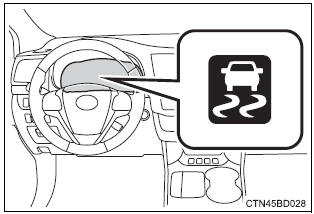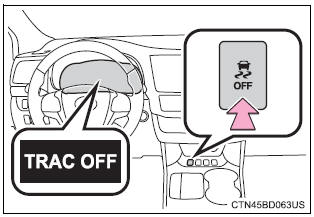Toyota Highlander Owners Manual: Driving assist systems
To help enhance driving safety and performance, the following systems operate automatically in response to various driving situations. Be aware, however, that these systems are supplementary and should not be relied upon too heavily when operating the vehicle.
Abs (anti-lock brake system)
Helps to prevent wheel lock when the brakes are applied suddenly, or if the brakes are applied while driving on a slippery road surface
Brake assist
Generates an increased level of braking force after the brake pedal is depressed when the system detects a panic stop situation
Vsc (vehicle stability control)
Helps the driver to control skidding when swerving suddenly or turning on slippery road surfaces
Enhanced vsc (enhanced vehicle stability control)
Provides cooperative control of the abs, trac, vsc and eps.
Helps to maintain directional stability when swerving on slippery road surfaces by controlling steering performance.
Trac (traction control)
Helps to maintain drive power and prevent the drive wheels from spinning when starting the vehicle or accelerating on slippery roads
Hill-start assist control
Prevents the vehicle from rolling backward when starting on an incline or slippery slope
Downhill assist control system (awd models)
Dynamic torque control awd system (awd models)
Automatically switches from front-wheel drive to all-wheel drive (awd) according to the driving conditions, helping to ensure reliable handling and stability. Examples of conditions where the system will switch to awd are when cornering, going uphill, starting off or accelerating, and when the road surface is slippery due to snow, rain, etc.
Eps (electric power steering)
Employs an electric motor to reduce the amount of effort needed to turn the steering wheel
Pcs (pre-collision system) (if equipped)
When the trac/vsc systems are operating
The slip indicator light will flash while the trac/vsc systems are operating.

Disabling the trac system
If the vehicle gets stuck in mud, dirt or snow, the trac system may
reduce power from the engine to the wheels. Pressing
 to turn the
to turn the
system off may make it easier for you to rock the vehicle in order to
free it.
To turn the trac system off,
quickly press and release  .
.
The “trac off” will be shown on
the multi-information display. Press
 again to turn the system back
again to turn the system back
on.

Turning off both trac and vsc systems
To turn the trac and vsc systems off, press and hold
 for more than 3
for more than 3
seconds while the vehicle is stopped.
The vsc off indicator light will come on and the “trac off” will be shown
on the multi-information display.*
Press  again to turn the systems
again to turn the systems
back on.
*: On vehicles with pre-collision system, pre-collision brake assist and precollision braking will also be disabled. The pre-collision system warning light will come on and the message will be shown on the multi-information display.
When the message is displayed on the multi-information display showing that trac has been disabled even if
 switch has not been
switch has not been
pressed
Trac, hill-start assist control and downhill assist control cannot be operated.
Contact your toyota dealer.
Sounds and vibrations caused by the abs, brake assist, trac, vsc and hill-start assist control systems
- Sound may be heard from the engine compartment when the brake pedal is depressed repeatedly, when the engine is started or just after the vehicle begins to move. This sound does not indicate that a malfunction has occurred in any of these systems.
- Any of the following conditions may occur when the above systems are operating. None of these indicates that a malfunction has occurred.
- Vibrations may be felt through the vehicle body and steering.
- A motor sound may be heard after the vehicle comes to a stop.
- The brake pedal may pulsate slightly after the abs is activated.
- The brake pedal may move down slightly after the abs is activated.
Eps operation sound
When the steering wheel is operated, a motor sound (whirring sound) may be heard. This does not indicate a malfunction.
Automatic reactivation of trac and vsc systems
After turning the trac and vsc systems off, the systems will be automatically re-enabled in the following situations:
- vehicles without a smart key system: when the engine switch is turned to the "lock" position vehicles with a smart key system: when the engine switch is turned off
- if only the trac system is turned off, the trac will turn on when
vehicle
speed increases
if both the trac and vsc systems are turned off, automatic re-enabling will not occur when vehicle speed increases.
Reduced effectiveness of the eps system
The effectiveness of the eps system is reduced to prevent the system from overheating when there is frequent steering input over an extended period of time. The steering wheel may feel heavy as a result. Should this occur, refrain from excessive steering input or stop the vehicle and turn the engine off. The eps system should return to normal within 10 minutes.
Operating conditions of hill-start assist control
When the following four conditions are met, the hill-start assist control will operate:
- the shift lever is in a position other than p or n (when starting off forward/ backward on an upward incline).
- The vehicle is stopped.
- The accelerator pedal is not depressed.
- The parking brake is not engaged.
Automatic system cancelation of hill-start assist control
The hill-start assist control will turn off in any of the following situations:
- the shift lever is moved to p or n.
- The accelerator pedal is depressed.
- The parking brake is engaged.
- Approximately 2 seconds elapse after the brake pedal is released.
 Warning Warning
Stopping distance when the abs is operating may exceed that of normal conditions The abs is not designed to shorten the vehicle's stopping distance. Always maintain a safe distance from the vehicle in front of you, especially in the following situations:
Trac may not operate effectively when Directional control and power may not be achievable while driving on slippery road surfaces, even if the trac system is operating. Drive the vehicle carefully in conditions where stability and power may be lost. Hill- start assist control
When the vsc is activated The slip indicator light flashes. Always drive carefully. Reckless driving may cause an accident. Exercise particular care when the indicator light flashes. When the trac/vsc systems are turned off Be especially careful and drive at a speed appropriate to the road conditions. As these are the systems to help ensure vehicle stability and driving force, do not turn the trac/vsc systems off unless necessary. Replacing tires Make sure that all tires are of the specified size, brand, tread pattern and total load capacity. In addition, make sure that the tires are inflated to the recommended tire inflation pressure level. The abs, trac and vsc systems will not function correctly if different tires are installed on the vehicle. Contact your toyota dealer for further information when replacing tires or wheels. Handling of tires and the suspension Using tires with any kind of problem or modifying the suspension will affect the driving assist systems, and may cause a system to malfunction. |
 All-wheel drive lock
switch
All-wheel drive lock
switch
All-wheel drive lock mode can be used when a large amount of
drive power needs to be applied to all the wheels, such as when
the vehicle gets stuck in mud and you need to free it.
Press the switch. ...
 Downhill assist control
system
Downhill assist control
system
With the downhill assist control system, the vehicle is able to
descend a steep hill, maintaining a constant low speed of about
3 mph (5 km/h) without brake pedal operation.
Activating the downhill ...
More about Toyota Highlander:
Tire inflation pressure
Tire inflation pressure
The recommended cold tire inflation
pressure and tire size are displayed
on the tire and loading
information label.
Inspection and adjustment procedure
Tire valve
Tire pressure gauge
Remove the tire valve cap.
Press the tip of the tire pressure gau ...
